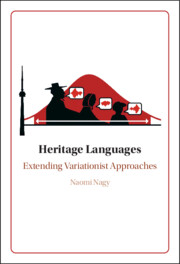Book contents
- Heritage Languages
- Heritage Languages
- Copyright page
- Epigraph
- Contents
- Figures
- Tables
- Acknowledgements
- Abbreviations
- 1 What Are Heritage Languages and Why Should We Study Them?
- 2 Experimental and Variationist Research on Heritage Languages
- 3 The Toronto Context
- 4 HLVC Methods and Tools
- 5 Cross-Variety Comparisons
- 6 Cross-Language Comparisons
- 7 Heritage Cantonese
- 8 Indexicality in Heritage Languages
- 9 Working with Heritage Languages in Linguistics Classes
- 10 What Heritage Language Speakers Tell Us about Language Variation and Change
- Bibliography
- Index
6 - Cross-Language Comparisons
Published online by Cambridge University Press: 09 July 2024
- Heritage Languages
- Heritage Languages
- Copyright page
- Epigraph
- Contents
- Figures
- Tables
- Acknowledgements
- Abbreviations
- 1 What Are Heritage Languages and Why Should We Study Them?
- 2 Experimental and Variationist Research on Heritage Languages
- 3 The Toronto Context
- 4 HLVC Methods and Tools
- 5 Cross-Variety Comparisons
- 6 Cross-Language Comparisons
- 7 Heritage Cantonese
- 8 Indexicality in Heritage Languages
- 9 Working with Heritage Languages in Linguistics Classes
- 10 What Heritage Language Speakers Tell Us about Language Variation and Change
- Bibliography
- Index
Summary
This chapter draws cross-linguistic comparisons among the patterns reported in Chapter 5 for three linguistic variables that occur in at least three languages in the project: (VOT), (CASE), and (PRODROP). Conditioning factors, both linguistic and social, are discussed. Collapsing across rate and constraint hierarchy for each variable, we note any indication of change in either. Half the context we examine exhibit stability. Of the eight that indicate difference, half of these can be attributed to English (including both convergence and divergence). With few differences between homeland and heritage speakers to work with, we find few generalizations about what parts of the language, or which languages, change. We do see more change in one morphosyntactic variable, (CASE), than in the phonetic variable (VOT), but less in the other morphosyntactic variable (PRODROP).
Keywords
- Type
- Chapter
- Information
- Heritage LanguagesExtending Variationist Approaches, pp. 159 - 166Publisher: Cambridge University PressPrint publication year: 2024

